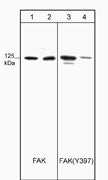
Catalog # FM1211
FAK (Tyr-397), phospho-specific Antibody
Mouse Monoclonal
| ELISA | 1:2000 |
| WB | 1:500 |
Size 100 μl
Species Reactivity Hu, Rt, Ms, Rb
MW 125 kDa
Isotype IgG1
Focal adhesion kinase (FAK) is a widely expressed cytoplasmic protein tyrosine kinase involved in signal transduction pathways important for cell spreading, migration and survival. Activation of FAK by integrin clustering leads to autophosphorylation at Tyr-397, which is a binding site for Src family kinases, PI3-Kinase, and PLCγ. The recruitment of Src family kinases results in the phosphorylation of tyrosine 407, 576, and 577 in the catalytic domain, and tyrosine 871 and 925 in the carboxy-terminal region of FAK. Thus, the phosphorylation of Tyr-397 is a critical step in the activation of FAK.
References
Cobb, B.S. et al. (1994) Mol. Cell. Biol. 14:147.
Schaller, M.D. et al. (1994) Mol. Cell. Biol. 14:1680.
Schlaepfer, D.D. et al. (1994) Nature 372:786-791.

Western blot analysis of HUVECs untreated (lanes 1 & 3) or treated with alkaline phosphatase (lanes 2 & 4). Blots were probed with mouse monoclonal anti-FAK (lanes 1 & 2) and anti-FAK (Tyr-397) (lanes 3 & 4).
*For more information, see UniProt Accession Q05397
The products are are safely shipped at ambient temperature for both domestic and international shipments. Each product is guaranteed to match the specifications as indicated on the corresponding technical data sheet. Please store at -20C upon arrival for long term storage.
*All molecular weights (MW) are confirmed by comparison to Bio-Rad Rainbow Markers and to western blot mobilities of known proteins with similar MW.
Product References:
Stone, JD et al. (2016) J Non Invasive Vasc Invest. 1:2-9. (FC: rat ATr5 smooth muscle cells)Oyanadel, C. et al. (2018) Mol Biol Cell. 29(5):557-574. (WB: MDCK cells)
Ma, SN et al. (2017) Evid Based Complement Altern Med. 2017:4535326. (WB: rabbit cartilage)
Abdel-Naby, W. et al. (2017) PLoS One. 12(11):e0188154. (ICC: rabbit cornea)
Creekmore, A.L. et al. (2013) Biomolecules 3(3): 386. (WB: mouse cells)
Teravainen, T. et al. (2013) PLoS ONE 8(8):e71485. (WB: MDCK cells)
Lin, S. & Mequanint, K. (2012) Biomaterials 33(29):7047. (WB: HCASMC)
Akama, K. et al. (2011) BBA Prot & Proteo. 1814(2):265. (WB: monkey neurons)
Kong, T. et al. (2009) Mol Biol Cell. 20:4596. (WB: canine MDCK cells)
This kit contains:








































